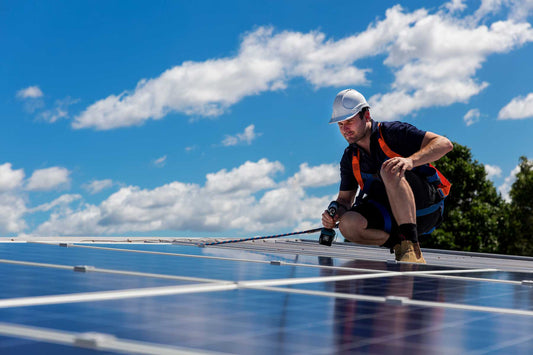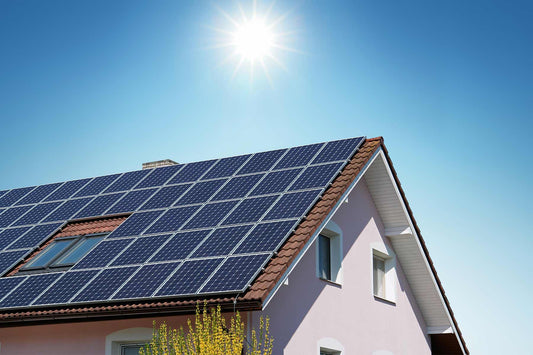To size a solar system, take your average daily usage and divide it by the average peak sun hours in your area. Multiply this number by your system's production ratio to determine your system size in kilowatt hours.
To determine how many panels you need, divide your system size in watt hours by your panel output rating.
Investing in solar is a wise move for any homeowner interested in generating their own renewable energy and cutting their energy bill.
That said, a lot of forethought must go into the type of system you build, as every homeowner’s needs and wants are different.
As you begin planning, one of the very first questions that should come to mind is “What size solar system do I need?”
You don't have to be a mathematician to calculate your solar system size. In this guide, we not only walk through how to size a solar system in six simple steps, but we also crunch the numbers ourselves in some solar system sizing examples to help you get started.
Considerations When Sizing a Solar System

While many considerations go into sizing a solar system, try not to feel overwhelmed. Some considerations will likely be more relevant to you than others, and the best system sizing option should feel intuitive.
Here are some of the most significant factors that may impact your decision:
- Budget: If you’ve defined a specific budget for your system, you may want to err on the lower end of the solar sizing spectrum.
- Space: Consider how space constraints (whether that be on your roof or the ground) might limit the size of your system to avoid over-sizing. If you anticipate expanding your system down the road, you’ll want to account for the space that additional panels would occupy, as well.
- Energy use: If your goal is to offset your entire energy bill, you’ll need a big enough system to support your household energy use.
- Sun exposure: Every area in the U.S. has its own number of peak sun hours. The fewer hours of sunlight your area has, the larger and more powerful your system may need to be.
- Product quality: How efficient are the panels you plan to buy? On average, modern solar panels have an efficiency rating of 16-22%, with older panels operating slightly less efficiently (15%-18%). They generate 170 to 350 watts every hour, or about 15 watts per square foot. If your panels fall on the lower end of the efficiency spectrum, you may need a larger system to generate your desired output. Likewise, you may want to check product reviews to see how efficiency deteriorates over time.
Solar System Sizing in 6 Steps

Sizing a solar system requires some calculations, but this process doesn’t have to be difficult. In this section, we’ll walk through every step of calculating your solar system size to help you feel confident you’re building an ideally sized system.
Step 1: Evaluate How Much Solar You Can Get
Before calculating your system size, it’s important to know how much solar you have the space and budget for.
Space
First, let’s discuss space. The average solar panel measures about 3 feet by 5 feet, or 15 square feet total.
Assuming you’re planning to install solar panels on your roof, you can divide your roof’s square footage by 15 to estimate how many solar panels will fit. If you want to avoid adding panels to a certain part of your roof, remember to subtract that space from your equation.
Budget
On average, solar panel installation costs between $17,500 and $23,500, or between $200 and $250 per panel. Your installation method, panel quality, and panel quantity will determine where your price falls. Solar panel quality encompasses factors such as efficiency, capacity, output, and longevity.
Before you determine your solar system size, it’s important to keep in mind what size and quality system your budget allows for.
Step 2: Calculate Your Average Daily Energy Usage (in kWh)
Sizing your system largely comes down to one question: “How much solar power do I need?” The answer is pretty straightforward — you need to generate enough solar energy to fulfill your daily electricity usage.
That said, every home uses a different amount of electricity. Knowing how many kilowatt hours (kWh) you consume is a critical first step when sizing your system, as this is how you determine how much energy you’ll need to generate to maintain your current lifestyle.
Calculating your average daily energy usage is very straightforward. Here’s how it’s done, step by step.
- If it’s been an average year of energy usage, collect your electric bills over the past 12 months. It’s a good idea to have a bill from every month of the year so that you include all of the peaks and troughs of electricity usage throughout the year. For example, during the summer, you likely run the AC much more often than you do in the fall and winter.
- If your energy usage this year has been out of the ordinary, refer to bills from a year that was more consistent with your habits. This way, you’ll be less likely to under- or over-size your system.
- Add your kWh from every month of that year together and divide that sum by 12 to get your average monthly energy usage.
- Divide your average monthly energy usage (in kWh) by 30. This number is your average daily energy usage.
Average daily energy usage (in kWh) =
sum of past 12 months' energy bills ÷ 12 ÷ 30
Step 3: Look Up How Much Sunlight Your Area Gets
Next, you’ll want to identify the peak sun hours in your area. For obvious reasons, the amount of sunlight your area gets will impact how big your solar system should be.
To get this number, search for your city in a sun hours chart or map such as the Global Solar Atlas. If using the Global Solar Atlas, look under “Site info” at “Global horizontal irradiation.” This number is how many peak sun hours your city gets in a year. Divide this number by 365 (days in a year) to get your daily peak sun hours.
For example, when searching for San Francisco, you’ll notice it gets about 1,818 peak sun hours per year. Divide that by 365 and you get about five peak sun hours per day. Hold onto whatever number you find for your area — we’ll be using it shortly!
Step 4: Estimate Your Solar Production (Efficiency) Ratio
A solar production (efficiency) ratio specifies how much energy a solar system should produce in relation to its size. This number should range between one and two.
We include the equation for finding your production ratio below, but don’t try to solve it just yet — read on to learn why it’s recommended to estimate your ratio instead.
Production ratio =
system production in a year ÷ system size (in watts)
As you can see, we have a problem. While you can ask your solar installer for their system’s annual production, the equation for determining your precise production ratio also requires your system size — a number we don’t have yet. For this reason, we recommend estimating your production ratio at this time.
See the table below for your own region’s production ratio range.
| Region | Typical Production Ratio Range |
|---|---|
| Northeast (e.g. MA, CT, RI) | 1-1.3 |
| Pacific Northwest (e.g. WA, OR) | 1-1.15 |
| Southwest (e.g. TX, AZ, NM) | 1.5-1.8 |
| Mid-Atlantic (e.g. MD, PA, DC) | 1.1-1.35 |
| Southeast (e.g. FL, GA, NC) | 1.2-1.5 |
| Mountain West (e.g. CO, UT) | 1.3-1.6 |
| West Coast (e.g. CA) | 1.4-1.8 |
| Midwest (e.g. IL, MI, MN) | 1.1-1.3 |
The above estimates will work fine when calculating your approximate solar system size. When in doubt, rely on the average across all regions of 1.35.
It’s important to note that system size isn’t the only consideration that goes into a system’s production ratio. Weather, panel direction, roof slope, and component efficiency can all impact this number. Use the above estimation as a starting point, but remember that these other factors can also impact your system’s ratio.
Step 5: Calculate Solar System Size
Congratulations! You now have everything you need to calculate the size of your solar system.
To size your system, take the daily kWh energy you calculated (from Step 1) and divide that by your average sun hours (from Step 2). Multiply that number by your production ratio (from Step 3) and you have your solar system size.
DC solar system size =
(Daily kWh usage ÷ average sun hours) x production ratio
Let’s consider an example.
Sarah and her family live in Phoenix, Arizona, and use 33 kWh of electricity per day. Since Phoenix is a part of the Southwest, Sarah estimated her production ratio to be 1.65. She then took a peek at the Global Solar Atlas to find that Phoenix averages about 5.8 sun hours per day.
Here’s how Sarah’s equation would look:
(33 kWh/day ÷ 5.8 sun hours) x 1.65 production ratio =
9.4 kWh DC solar system size
Individual solar panel output is measured in watts, so Sarah knew she had to convert the system’s kWh to watts. She multiplied 9.4 by 1,000 to determine that she needed about 9,400 watts’ worth of solar panels to power her home.
Step 6: Determine How Many Panels You Need

Now that you know your system size, you have what you need to answer the final question when sizing a solar system: “How many solar panels do I need?” To determine this, divide the size of your system in watts by the average output per solar panel.
To get the most accurate solar panel output, consider asking your installer about the output of the panels they offer. You can also use the output rating of panels on today’s market, which falls between 250 and 400 watts (averaging 325 watts).
In the above example, Sarah would take the 9,400 watts she calculated and divide it by the average output rating (325). Here’s what her equation would look like:
9,400 watt system size ÷ 325 panel output rating =
about 29 solar panels
While the answer to the equation above is actually 28.9, it’s a good idea to round up to ensure your system will be large enough to accommodate your electricity use.
Example Solar Need Calculations
Let’s walk through some examples of common solar sizing questions and how to calculate them.
How Many Solar Panels Do I Need for a 2,000-Sq.-Ft. Home?
While the square footage of your home doesn’t necessarily determine how much energy you use, we can estimate based on the average usage of a home of that size.
Let’s assume you own a 2,000-square-foot home in Denver (4.8 peak sun hours) and consume an average of 30 kWh/day. Assuming your panel wattage is about average (325) and your production ratio is 1.45, you’ll need:
(30 kWh/day ÷ 4.8 sun hours) x 1.45 production ratio =
9 kWh DC solar system size
9 kWh x 1,000 =
9,000 watts required
9,000 watt system size ÷ 325 panel output rating =
about 28 panels
Of course, take this number with a grain of salt. It can vary quite a bit depending on your energy usage, your area’s production ratio and peak sun hours, and your solar panels’ efficiency.
How Many Solar Panels Do I Need For 1000 kWh per Month?
Assuming your panel wattage is average (325) and you live in Miami (meaning your production ratio is about 1.3 and you get about 5.3 peak sun hours), here’s what your equation would look like if you wanted to generate 1,000 kWh per month (33.3 kWh per day):
(33.3 kWh/day ÷ 5.3 sun hours) x 1.3 production ratio =
8.2 kWh DC solar system size
8.2 kWh x 1,000 =
8,200 watts required
8,200 watt system size ÷ 325 panel output rating =
about 25 panels
Once again, this number can vary based on your area’s production ratio, your local peak sun hours, and your solar panels’ efficiency. Be sure to research these factors before determining your system size.
Solar System Sizing FAQ
Sizing a solar system requires some detailed calculations and can feel confusing, so it’s natural to have some questions about the process. Below, we address some common questions.
How Many Watts of Solar Do I Need?
How many watts of solar you need depends on a few factors, including:
- How many kWh you consume
- Your area’s peak sun hours
- Your panels’ production ratio
Here is the equation to calculate how many watts of solar you need:
DC solar system size =
(Daily kWh usage ÷ average sun hours) x production ratio
That said, if you don’t plan to offset all of your electricity usage with solar, then you can replace daily kWh usage with however many kWh you’d like to offset.
How Much Does a 10kW Solar System Produce?
A 10kW solar system produces 29-46 kWh per day, meaning somewhere between 10,000-16,000 kwH per year. This number varies based on system efficiency. Check with your solar producer to confirm where your system falls.
What Is a Good Solar System Size?
A good solar system size is relative to each household, as it largely depends on individual energy consumption.
An average home of about 2,000 square feet that consumes 950 kWh/month and averages four peak sun hours would want about a 10-12 kWh DC system.
Now that you know the steps needed to size your solar system, you’re ready to move forward with solar installation.
We source our solar panels from reliable manufacturers who prioritize efficiency while keeping the cost of solar affordable. With Solartap, you can feel confident that your individual solar needs will be met at a fraction of the cost of other providers.
Once you’ve sized your solar system, get a quote using our solar calculator today.




